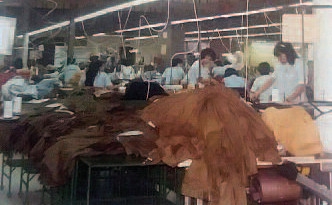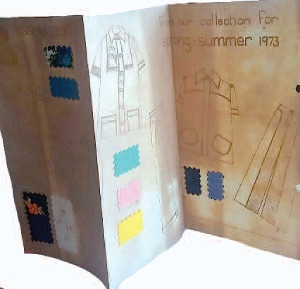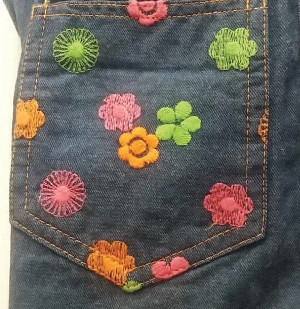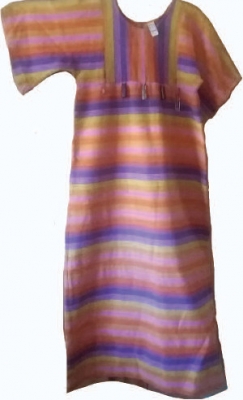My Life in The Rag Trade
Photos by Marion Stone
It all began when I heard curator Efrat Assaf Shapira speak at the new exhibition on Israeli Fashion at the Israel Museum. She was so interesting to listen to as she took my mind back to the years when I worked in the fashion industry here in Israel. I suddenly realized that there were times when I was a part of the story.
Efrat spoke about the beginnings of clothing manufacture on a large scale and gave an overview from the early 20th
century when immigrants were arriving in Israel from Europe and America; how it grew in the 1920s and 1930s; hit a high after the Six-Day War and disappeared when competition from the Far East took over the retail market.
For a short while, I was a part of what was happening and have been through the good and bad of the story.
I had studied the technology of clothing manufacture and textiles at the College of Technology in Leeds, England, which had a strong bias for tailoring processes. In 1971, I found myself on a World Union of Jewish Students Program for graduate students in Arad. Armed with very little Hebrew after a five month ulpan, I moved to Tel Aviv and looked for work.
This was the time when clothing and other designed products, such as ceramics, took their inspiration from local climatic conditions and biblical landscape. Israel is, after all, located in the Middle East.
It was the only time in my life that I had a choice of five offers and I decided to work for a company in central Tel Aviv, with a production manager from London. 'Bashan' was a fast growing sub company of now defunct Textil Bet Shean Nazeret, which decades ago merged into what is today's Kitan. The company had found a unique signature for denim fabric. It was embroidered with flower designs, and their designer was creating some winning modern styles, close to the traditional work clothes produced by Levi Strauss. Having shown their garments at International Fashion weeks, Bashan was raking in huge orders from the world's top retailers.
While our 'big boss' was preparing to go to a Fashion Week in Italy, at the last minute the marketing manager realized that we didn't have any printed brochures or handouts, and a panic began. So I created a leaflet by sketching some of our latest styles and sticking a small sample of fabric near each style. It was accepted, and by the following day, most people in the office were working to help produce, by hand, as many as possible of these leaflets, before the marketing manager left for Italy.
Since the company worked with small sewing factories in the West Bank and Gaza, there was some kind of security connection. The 'big boss' was a retired senior officer in the IDF.
One day, shortly before I left to return to England, I was standing on a chair in the office, arranging something on the wall. I heard the door open and close, but no other sound. When I looked around, I almost fell off the chair. A tall, dark and handsome man wearing a long, black robe, and a red turban on his head, had entered the room and he told me he had an appointment with the production manager. When he left, I was intrigued to know who he was and was told that he was the nephew of the Samaritan High Priest who had a small factory in Shechem (Nablus). A production consultant, Mr. Bloch, who was helping the company, would be visiting to check it out the following week. I asked if I could go too, and was thrilled that I could.
I will never forget that visit. We first saw the factory, and then we were taken to the home of the High Priest and we were introduced to him. Refreshments were served, and the nephew's son was called to recite, in Aramaic, his recent bar mitzvah piece. We were then taken up to Mount Gerizim and were shown the holy sites of the Samaritans, including the place where they sacrifice animals at Pesach. I still clearly remember seeing the burnt wool and charred remains.
Before we parted, Mr. Bloch gave me his phone number and address and told me to contact him when I decide to make aliyah and need to find work. It was a good feeling to know that I had a source for help.
This was 1971: the euphoria after the Six Day War affected every aspect of business in Israel, but unfortunately in many industries, people were not professionally trained in modern management skills. Poor and inconsistent quality standards, and not much understanding of the importance of delivery dates led to many companies not being able to follow through on their commitments. I returned to England in August, 1972 and made aliyah in 1979, believing that I would be able to succeed in a career and make my contribution to the Israeli clothing manufacturing industry.
How naïve could I be? By 1979 the fashion industry's high was sinking fast after the economic effects of the Yom Kippur War, and a change in government policy.
In 1955, Pinchas Sapir had encouraged the clothing and textile industry with incentives, but by 1970s there was a dramatic change of policy and the industry lost a lot of benefits. By then there was stiff competition from abroad as import tariffs were made more attractive. As a result, I suffered greatly from long periods of unemployment when every company I worked for either cut down or closed down, and suitable positions were not available.
The theme of Biblical and desert Middle Eastern influence had gone, and in its place was modernistic inspiration of design, and reflections of the latest styling from Europe, and worse still – clothing was being imported cheaply to Israel from the Far East.
In October, 1979, I was offered a position at the ATA Company in Karmiel. ATA was the first tiered textile, clothing and retail company that was established in Kiryat ATA, just north of Haifa by Hans and Erich Moller around 1934-5. ATA spun threads, wove fabrics, sewed clothes and linens and sold them in their own shops, and also produced clothing for export and the IDF. The Moller family cared for their employees and built housing in the vicinity for employees, especially those brought from Europe as new immigrants.
ATA was a household name in the 1940s, 50s and 60s. During World War II, the company was tremendously busy making military uniforms for the British, khaki work-clothes for kibbutzniks, and the basic utility garments that everyone needed. Once the economy in Israel improved, consumers became more materialistic and wanted more stylish garments. Unfortunately, ATA wasn't able to keep up to date, and lost business to newer, more fashionable manufacturers.
Some old archive film is being shown in the exhibition at the Israel Museum, as well as some typical ATA garments of the time.
I had three managers. Yossi managed all the ATA factories. Shmulik was the Karmiel factory manager and my immediate boss was also called Yossi. On my first day, he told me that he wanted to speak English with me to improve his English, but by then I had learned that if I was to master Hebrew I must persevere with the language. We came to an agreement that he would speak to me in English and I would speak Hebrew. And that's how we continued.
There was a 'big boss' who was due home from a visit abroad, and he came to the factory on the second day I began working there. There was a flurry of voices and much excitement on the factory floor, and I went to see what was happening. 'Big boss' had arrived and was greeting the workers as he walked along the production lines. He was obviously very popular and well-liked. I couldn't believe my eyes. 'Big boss' was Mr. Bloch! When I was introduced to him, he didn't recognize me, but when I explained, of course he remembered me and I felt a little more secure in this new and strange environment that I found myself in.
On his way home that evening, Mr. Bloch was tragically killed in a car crash. At work, the following week, the three young managers were devastated, because he had been a mentor to them.
That same month, ATA's financial troubles became the beginning of the end for the company, and for the next five or six years, every day was uncertain until the company was closed down by court order on 31st May 1986. We employees had loyally continued to work in the hope that our places of work would be saved. We wanted to stay together. We demonstrated, kept a vigil, tried so hard, but it wasn't to be.
Over the ensuing years, I was in and out of work as other companies ran into trouble. When I finally gave up with the industry, I felt a deep bitterness that I had so much knowledge and skill, plus a wide technical vocabulary in Hebrew, and it was all a waste.
At the end of the curator's talk, I spoke to Efrat and told her that I have a Rikma dress that I bought in 1972, and also some garments from Bashan, and she said that the museum may be interested to take them, and if not, it was possible that the Shenkar College of Design would accept them. Shenkar is interested, and at time of writing, may also take my college work – the hand drafted patterns, the books of stitched dressmaking and tailoring samples – for their archive. I bought my first Vogue magazine in 1959, and kept a collection of Vogue and Harpers Bazaar through the 1960s and 1970s. I hope that they may also be interested in these.
So maybe my professional background has a use after all.












Comments